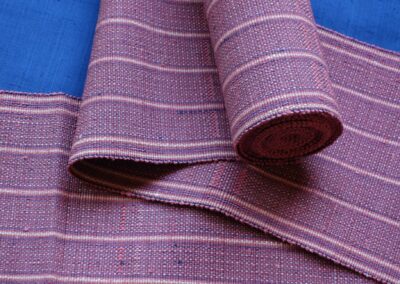Obi – Blue Red Stripes
This combination of blue and red reminds me of the textile in mountainous regions stretching over Thailand, Laos and Vietnam. Their indigo-dyed, wax resist patterns, usually decorated with red or colourful threads embroidery. I am not knowledgeable enough to point out the name of the people, but very appreciative of any tips or insider information!
Tsumugi silk pongee half-width obi woven by Yoshiko Munehiro. She did, as far as I remember, start working on these colour combination and stripes after her trip to the countries.
¥55,000
In stock
Additional information
| Weight | 200 g |
|---|---|
| Dimensions | 380 × 17 cm |
| Color | Red, Blue |
| Maker | Yoshiko Munehiro |
| Material | Silk |
Full Product Details
Yukata (summer cotton kimono) season! If Kimono seems too “trying” in wearing i.e. too many layerings and strings. Then definitely start with Yukata.
Hanhaba-Obi (half-width belt for kimono) is the perfect company for such occasions, though can be worn with kimono all year round, too.
The weaver Yoshiko Munehiro is a strong advocate of half-width obi. What becomes available when the width is halved are…
- It’s easy to wrap & tie, as opposed to a regular belt which you need to fold in half first.
- It’s lighter: half the weight. (simple math!)
- It’s cooler: less layers, more breathable.
Overall, it’s good for summer; good for beginners. The link below shows you one of many ways to tie your belt. But honestly, you can freestyle with it once you understand the basic rule; wrap and tie.
https://www.kimono-plus.com/movies/84/lang/ja-JP/17
This combination of blue and red reminds me of the textile in mountainous regions stretching over Thailand, Laos and Vietnam. Their indigo-dyed, wax resist patterns, usually decorated with red or colourful threads embroidery. (I am not knowledgeable enough to point out the name of the people, but very appreciative of any tips or insider information!)
Yoshiko Munehir did, as far as I remember, start working on these colour combination and stripes after her trip to the countries.
The material is tsumugi silk pongee, a kind of silk traditionally hand-spun. It utilises every part of silk threads, including bumps and knots, which gives it warmth and a look similar to cotton. This distinctive texture is ideal to use as a belt; wrapping around and tying is easy. For its nature, tsumugi once was categorised as daily wear, not suitable for a formal occasion. Now some of the tsumugi kimono have actually become more expensive than the formal kimonos, for their rarity.
Hanging a favourite piece of textile changes the entire space. This common practice among fabric lovers should be shared; hang it on your wall or ceiling, or let it spread across your couch. Much easier to switch around than wallpaper.
The more you use it, the texture gets softer, which makes it easier to use. A virtuous cycle there.
Read more about Yoshiko Munehiro










